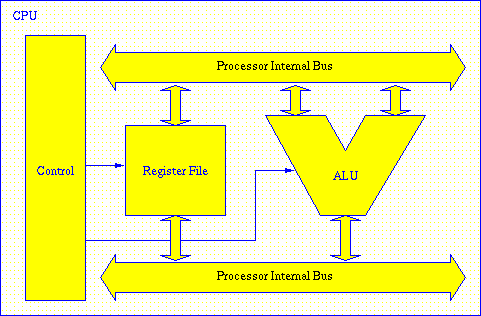CSE 30 -- Lecture 1 -- Sep 24
This lecture covers basic computer organization: processor, memory,
and I/O devices on a system bus, and the processor's internal
structure of control logic, functional units, and internal busses.
(This is a slightly different -- more detailed -- picture than that
given in the book.) We also started to talk about RISC and CISC
processor designs.
Inside the Computer

I/O devices include displays (graphics adapters), disk controllers,
audio cards, network interfaces, etc.
Buses (the other spelling, "busses", are
pecks on the cheek) are just bundles of wires for carrying related
electrical signals. The system bus includes two subcomponents, the
address bus and the data bus. When the CPU fetches instructions or
data, it places the address of the instruction or data on the
database, and the memory module recognizes the address as
`belonging' to it and responds by places the memory contents (the
instruction or the data) on the data bus, whereupon the CPU will sense
the value. You should think of the memory module as a large array,
and an address as simply an integer index into the array.
This integer is sent over the address bus in binary form -- each wire
has two valid voltage levels -- and similarly, the data is read from
the memory as a binary value.
The CPU has internal modules too:

The register file is another sort of memory -- there are only a few of
them (on the MIPS architecture, there are 32), but access to their
contents is extremely fast, because they are on-chip. Main memory,
outside of the CPU, is implemented in DRAM (Dynamic Random Access
Memory) on separate chips. There is a huge amount of main memory in
comparison: most machines these days have 32-512 MB (MB stands for
"MegaByte" == 2^20 bytes or approx 10^6 bytes), in comparison to
32*4=128 bytes in a typical register file. Access main memory,
however, is slow, since the CPU send signals vast distances (a few
inches) to the memory and wait for the response. Compared to on-chip
distances of millimeters or less, the time required for the signals to
propagate over the fifteen centimeters or so is enormous -- electrical
signals travel at the speed of light in its medium, and over copper
wires is something like 2/3 the speed of light in vacuum,
Compilers generally keep variables in main memory, and registers are
used to hold temporary copies of them while the CPU is modifying the
variables. Indeed, most RISC instruction sets do not allow directly
modifying memory -- they employ a ``load/store'' architecture, where
memory contents must be loaded into a register before being used.
Some very frequently used variables may be kept in a register for
efficiency. In C and C++, the register storage class
specifier tells the compiler that the programmer believes that the
variable will be heavily used, as a hint to give greater priority to
placing that variable over others in a register.
Coming next tuesday: caches, change of base, computer arithmetic,
number representation, instruction sets.
[
search CSE
| CSE home
| bsy's home page
| webster i/f
| yahoo
| hotbot
| lycos
| altavista
]

bsy+www@cs.ucsd.edu, last updated Mon Nov 30 21:53:14 PST 1998.
email bsy & tutors



